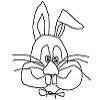The dangers of squib loads
What's a squib load you ask? It's when, instead of a bang following the squeezing of a trigger, one hears nothing or a pop. Typically, the situation is associated with a barrel obstruction in that the bullet of the round just "fired" hasn't cleared the barrel and is now obstructing it instead. The danger of the situation is that someone who isn't paying attention will simply eject the just "fired" case, chamber another round and squeeze the trigger again. Kaboom!
The most common manifestation of a squib is a round constructed without a powder charge; primed case, bullet, but no powder. Apparently, the pressure developed by a fired primer in the small space of a pistol calibre cartridge is sufficient to drive the bullet partway down the bore. The question I always had: will the bullet be driven far enough down the bore to allow the unobstructed chambering of another round in the chamber? Here we find out.
For this experiment, I built a powderless 45 ACP squib using a Remington 185gr JHP bullet and fired it in a model 21 Glock. Note, that this should not shed poor light on Glocks. This was an INTENTIONAL squib. After chambering and firing the squib, I disassembled the weapon and looked into the bore. Sure enough, the bullet was stuck slightly ahead of the chamber.

How far in is the bullet? To answer this question, we use some high tech measuring equipment; a chopstick, a black, felt-tipped marker and a measuring tape.
We first insert the fired case into the chamber, and ascertain where the base of the case sits with respect to the barrel.
We then remove the case, stick the chopstick into the breech-end of the barrel as far as it will go (until it touches the barrel obstruction) and mark the chopstick at the point where the base of the case would be.
Finally, we remove the chopstick and place it on a tabletop alongside the tape measure. We now remove the bullet obstructing the barrel by placing a wood dowel into the muzzle end of the barrel and then gently tap the dowel into the barrel until the obstructed bullet pops out the breech end of the barrel. We then line up the case alongside the chopstick so that the base of the case is flush with the black mark on the chopstick, and the end of the chopstick is flush with the base of the bullet. Tada! We have a measure of how far the bullet traveled down the bore before it stuck.
By my measure, the bullet was forced down the barrel a good half-an-inch past the case mouth ... JUST ON PRIMER PRESSURE ALONE. That's certainly enough to allow an unobstructed chambering of another round behind it, potentially leading to a dangerous kaboom for one who is not paying attention.
You have been educated ... and warned. Be safe and remember: the only safety you can rely one is the one between your ears.


6 comments:
Daniel Bernoulli has been my top hero for quite some time, but you're giving him a run for his money!
I've never experienced a squib load. I assume the difference in sound is obvious even through "ears?"
You should feel almost no recoil, also, right?
Oh yeah; there's definitely a difference. But typically one cannot "hear" a squib, and especially not in a semi-auto. The cylinder gap in a revolver will allow a squib to make some noise.
And yes, there's almost negligible recoil and that should be the tip-off. If you're expecting a bang and a kick, and you hear and feel neither .... STOP ... THINK ... ASCERTAIN. The beautiful face you ruin if you don't pay attention is only your own. :-)
Great post. Very interesting. Question: a friend told me about some .22LR rounds available (not in CA,of course!) that are primer only, so they are very quiet. Is this true, and if so, are you risking possible obstruction using them?
Did the gun eject the case when you fired the squib? Thanks for this very to-the-point post.
DKDay
Kevin:
Yes, Aguila Collibri or Super-Collibri are primer-only rounds. I've shot them and never had an obstruction. This leaves me to conclude two things: (1) the combination of a small diameter and a soft lead bullet results in little barrel friction, and (2) the tiny volume of a 22LR round results in enough pressure being generated by the primer alone to completely push the bullet out the barrel. I've clocked Collibri bullets exiting at about 300-350fps, but the manufacturer does warn not to use them in long guns.
YMMV ... be safe. :-)
DKDay: No, the case was not ejected, and there was little noticeable movement of the slide.
Post a Comment